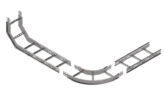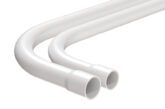
In this article the experts at D-Line provide the case for surface installations.
How to route cables is often a primary consideration of any installation. In a new build the practicality of using ceiling voids, the space under a floor, or the cavity behind a wall, will often make recessing an obvious choice. However for buildings in-use such options might not be practical, with direct-to-surface the most glaringly obvious route.
At D-Line we appreciate a drawback to surface wiring has traditionally been a reticence to have decor spoiled by blocky and sharp-edged strips of surface mounted plastic. As they were first developed in the 1950s and have changed little since, it is not surprising that traditional mini-trunking choices can look unfashionable in modern surroundings. Then there is also the risk of the lids and accessories detaching over the course of time.
The legacy is not only the enduring eyesore that spoils interior designs – consider that for I.T and network installations, AV equipment, new switches and sockets, and fire and security upgrades, the equipment may be the most expensive element of an installation – but it is the trunking that will be the most conspicuous element for years ahead.
So it is that making channels in walls has often got a resigned nod in spite of all the disruption and time involved, plus the need to then co-ordinate with plastering and decorating works to repair the surface. Recessing can be a big price to pay, however, just to avoid using mini-trunking.
To give fullest consideration, aside the finished appearance, thoughts of future safety and cable protection must be paramount too. Never mind the aesthetic shortcomings of mini-trunking, surface installations provide an on-going peace of mind that cables are securely encased. For example, there can be no danger of cables being smothered to compromise airflow around cables, of striking a buried cable by careless drilling to hang whatever to a wall, or of unwelcome rodents finding ways to gnaw through insulation.
D-Line trunking was developed in the UK after calls from electricians and contractors for an attractive, easy-to-install surface solution that addressed the drawbacks of either making channels in walls, or else using traditional mini-trunking.
The iconic D-shaped profiles, in patented single-piece designs, provide surface trunking solutions that are not only quick to install but can blend with décor – a ‘best of both world’s’ solution in keeping with the company’s commitment to producing innovative cable management solutions for use whenever time, safety and appearance matter. Since launching in 2006, over 20 million metres of D-Line trunking has been installed – the third-way to route cables has been a long-overdue option for installers.
Having invented the first fire-rated clips that can be used in non-metallic trunkings, D-Line welcomes that the pending 18th Edition requires that all surface cabling is secured by certified fire-rated fixings also, to prevent the potentially fatal risks of cable entanglement that can occur in any part of a burning building.
New profiles and accessory options have been recently added to the range – all designed to strengthen options available to installers who are forever querying the choices of how best to route and safely contain new cables.
For more details about the range of surface trunking from D-Line visit: www.d-line-it.com









